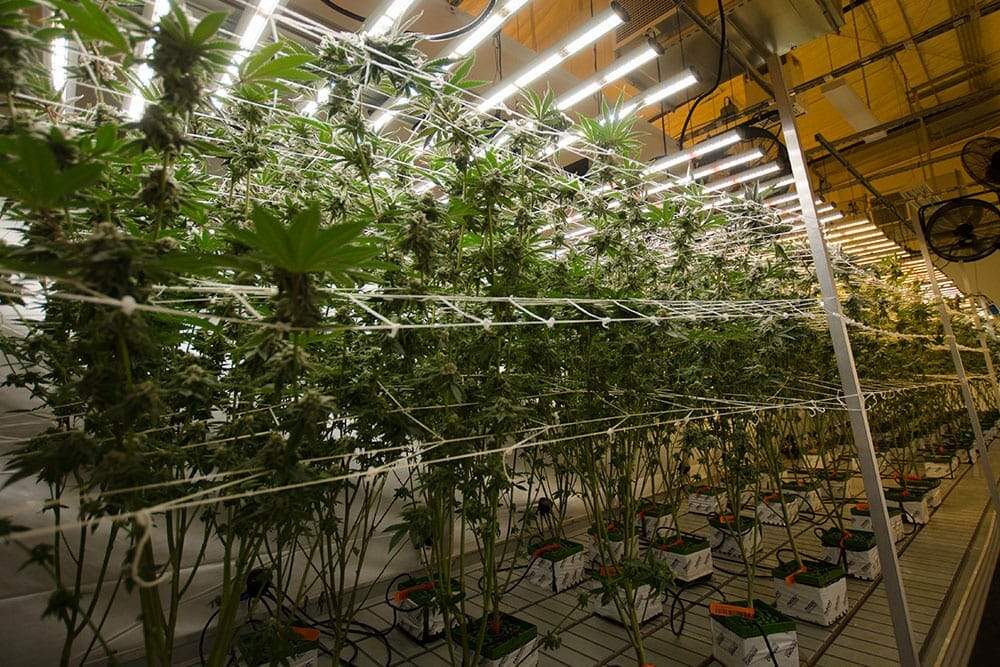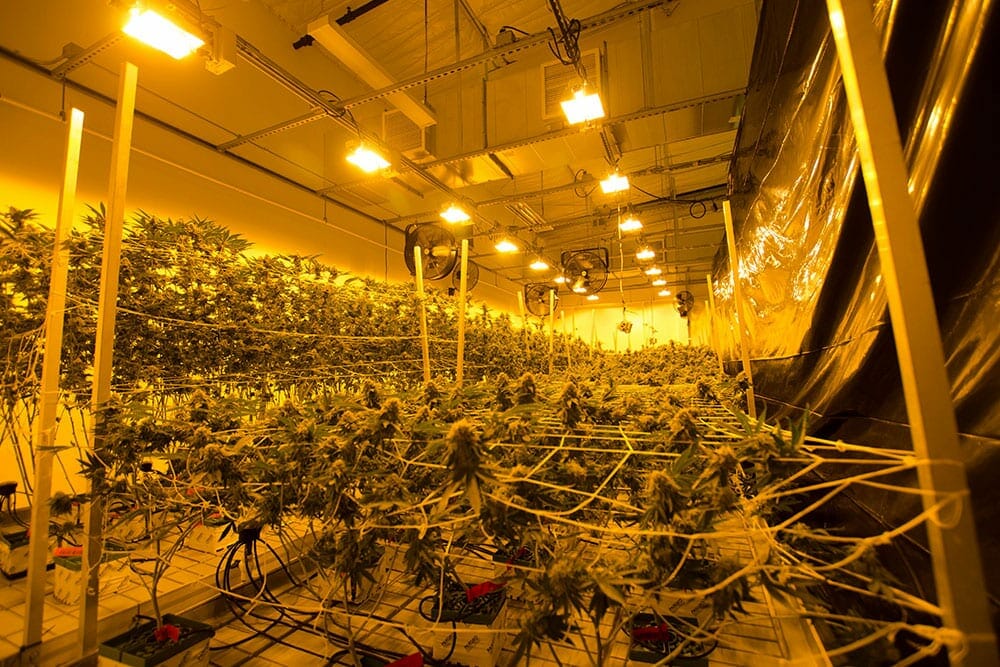Innovator Spotlight: OutCo
San Diego, California
Using the training they received in graduate school (Allison is a graduate of Clemson University with a Ph.D. in Plant and Environmental Science and Josh a graduate of Purdue University with a M.Sc. in Horticulture), the team developed a protocol to evaluate the impact of light intensity on plant growth and development. To determine the “optimal” light intensity for yield and secondary metabolite production, particularly total active cannabinoid concentrations, the experiment evaluated the effect of five light intensities (see Table 1) during the flowering stage of the cannabis strain “Hazy OG”. Fluence LED grow lights with PhysioSpec IndoorTM (a broad spectrum) provided an average PPFD of 400, 600, 800, and 1200 µmol/m2/s (see Photo 1). Double ended HPS fixtures that provided an average PPFD of 700 µmol/m2/s served as a commercial control (see Photo 2).
| Light Intensity Treatments | ||
|---|---|---|
| Light Fixture | Average PPFD | Average DLI |
| Fluence LED | 400 µmol/m2/s | 17.3 mol/m2/d |
| Fluence LED | 600 µmol/m2/s | 25.9 mol/m2/d |
| 1000W DE HPS | 700 µmol/m2/s | 25.9 mol/m2/d |
| Fluence LED | 800 µmol/m2/s | 34.6 mol/m2/d |
| Fluence LED | 1200 µmol/m2/s | 51.8 mol/m2/d |
| Environmental Conditions | |
|---|---|
| Average Temperature | 23.7 ± 1.7 ºC |
| Average Relative Humidity | 52.5 ± 3.2 % |
| Average CO2 Concentration | 1511 ± 71 ppm |


Three of the main factors analyzed in this double replicated study were shoot fresh weight, total cannabinoid concentrations, and trimmed flower weight.
Under the five treatments, the average shoot fresh weight had a near linear increase as light intensity was increased. The largest increase occurred when the light intensity was increased from 400 to 600 micromoles, which resulted in a 26% increase (see Figure 1).
To the surprise of the researchers, there was very little difference in cannabinoid concentrations between LED treatments, regardless of light intensity. However, all of the LED treatments showed an average increase of 12% in total active cannabinoids compared to the HPS treatment (see Figure 2). This indicates that light spectrum significantly influences total active cannabinoid concentration, and to a lesser degree light intensity
Under the five treatments, there was a near linear increase in trimmed flower weight, with the greatest increase occurring when PPFD was increased from 400 to 600 µmol/m2/s (see Figure 3). Although the data shows a near linear increase in trimmed flower weight, the percentage increase between the 800 and 1200 µmol/m2/s treatments seems to indicate 1200 µmol/m2/s is likely nearing the light saturation point.
The results of the trial provide important data on how cannabis, specifically the strain Hazy OG, is influenced by light intensity. Overall, as light intensity increased, yield increased on a near linear scale. While the impact of light intensity had a minimal effect on total active cannabinoids in the LED treatments, there was a 12% increase when compared to the HPS treatment. This provided valuable data for Allison and Josh to develop a hypothesis for their next experiment, which is to evaluate the impact of light quality (i.e. spectrum) on yield and total active cannabinoids.
Ultimately, the trials conducted by OutCo and Fluence will help cultivators determine the optimal lighting solution to maximize yields, increase potency, which in turn will increase revenue for businesses. “When we deployed Fluence SPYDRx PLUS in the trial [the fixture used to deliver 800 PPFD], we saw a 13.5% increase in yield, while using 44% less energy than our double ended HPS fixtures. For us, that’s huge. This doesn’t even take into account the energy savings from a reduced HVAC load,” said Allison. Under the Fluence SPYDRx PLUS, Hazy OG produced 66 grams per square foot, a 14% increase over plants grown under HPS, while drawing nearly half the electricity (see Table 3).
| Treatment | Power Consumption | THC Potency | Yield |
|---|---|---|---|
| LED 400 µmol/m2/s | 330W | 21.4% | 34.2 g/ft2 |
| LED 600 µmol/m2/s | 560W | 21.7% | 51.7 g/ft2 |
| HPS 700 µmol/m2/s | 1045W | 19.1% | 57.1 g/ft2 |
| LED 800 µmol/m2/s | 660W | 21.4% | 66.0 g/ft2 |
| LED 1200 µmol/m2/s | 1000W | 20.8% | 72.0 g/ft2 |